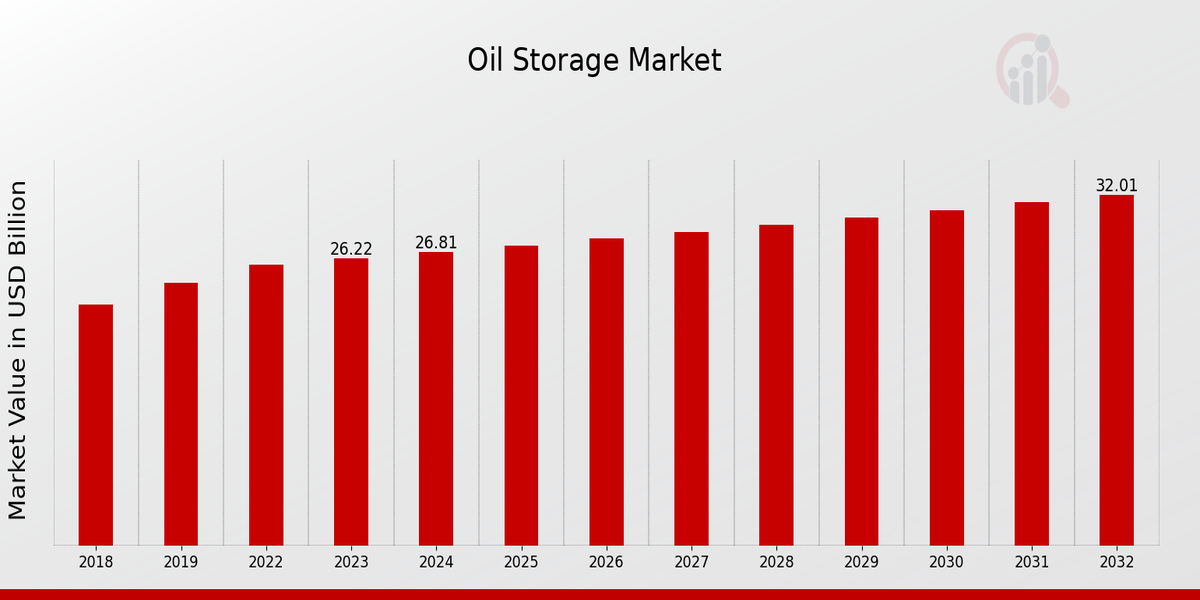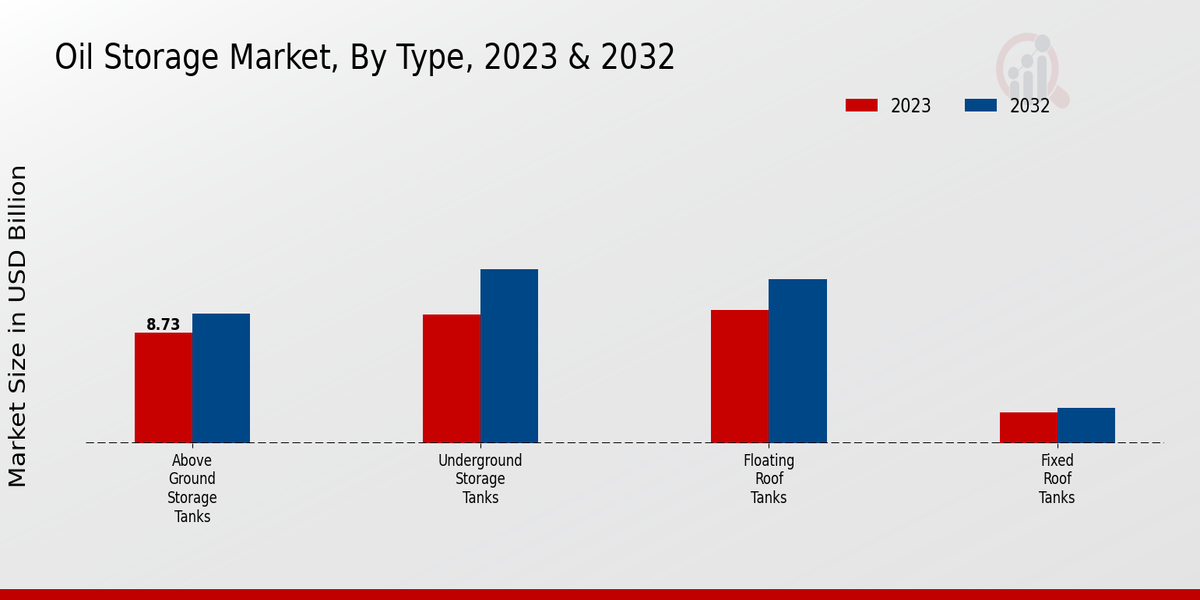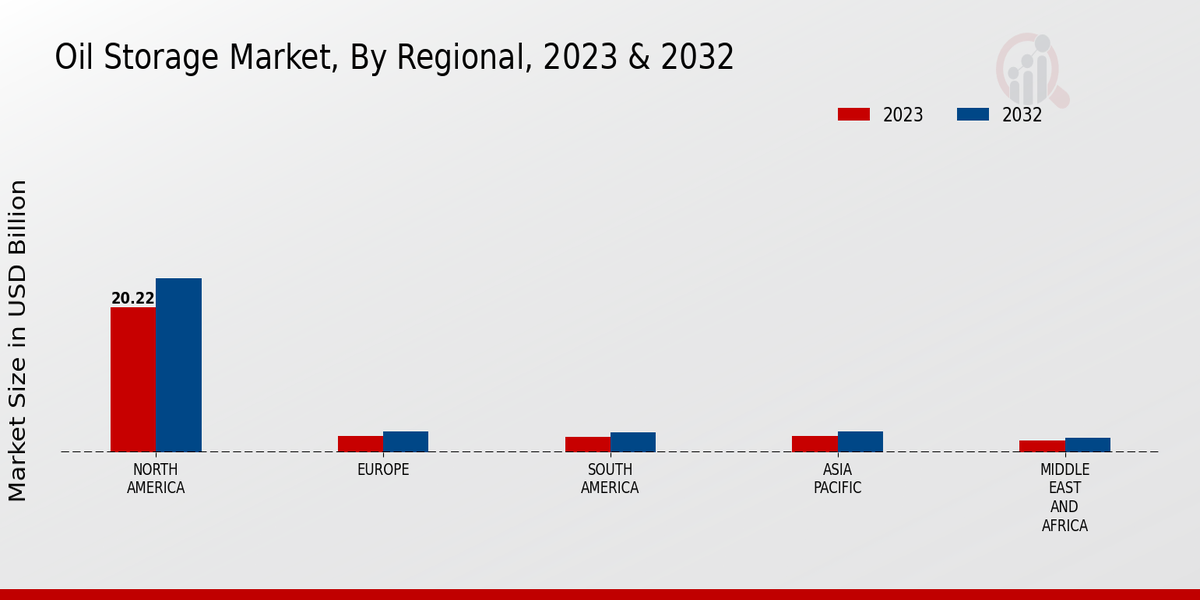Global Oil Storage Market Overview
As per MRFR analysis, the Oil Storage Market Size was estimated at 27.41 (USD Billion) in 2024. The Oil Storage Market Industry is expected to grow from 28.03 (USD Billion) in 2025 to 34.22 (USD Billion) till 2034, at a CAGR (growth rate) is expected to be around 2.24% during the forecast period (2025 - 2034).
Key Oil Storage Market Trends Highlighted
Even demand for oil storage facilities is driven up thanks to high energy consumption rates around the world, an increase in crude oil outputs and a requirement for insurance supply. Although the energy transformation is broader, it is emerging economies making the most out of it and therefore increasing energy needs and thus more room for oil.
New market segments like underground storage and using floating storage units are growth areas in the market. Improvements in technology, especially in storage and optimization, will help achieve higher effectiveness while minimizing costs. Also, the shift toward renewable kinds of energy presents room for working together in the oil storage business and energy transition.
There are obviously rapid changes in the industry as it embraces more automation and artificial intelligence is taking over the aspects of inventory management and influencing it. Besides, the rising use of internet-based cloud data management systems is improving the operation of data storage as well as data availability in use. New collaborations between energy companies and logistics companies are also starting that can optimize the supply chain. Such opportunities and trends in the oil storage market can be tapped to grow the businesses in the respective markets.

Source: Primary Research, Secondary Research, Market Research Future Database and Analyst Review
Oil Storage Market Drivers
Rising Global Energy Demand
The increasing global population and rapid industrialization are driving up energy consumption worldwide. As a result, the demand for oil, a primary energy source, is expected to continue to grow in the coming years. This increased demand is putting a strain on existing oil storage infrastructure, creating a need for new and expanded storage facilities. The Oil Storage Market Industry is expected to benefit from this growing demand, as it will require additional storage capacity to meet the needs of consumers.
Geopolitical Tensions and Supply Chain Disruptions
The ongoing geopolitical tensions and conflicts around the world are creating uncertainty in the global oil market. These tensions can lead to supply chain disruptions, which can impact the availability and price of oil. In such scenarios, oil storage becomes crucial to ensure a stable supply of oil to consumers. The Oil Storage Market Industry can benefit from these geopolitical uncertainties, as it provides a buffer against supply disruptions and helps to mitigate price volatility.
Technological Advancements and Efficiency Improvements
The Oil Storage Market Industry is also being driven by technological advancements and efficiency improvements. New technologies, such as automated storage and retrieval systems, are being adopted to improve the efficiency and safety of oil storage operations. Additionally, advancements in materials science are leading to the development of new storage tanks and equipment that can withstand harsh conditions and reduce maintenance costs. These technological advancements are helping to drive down the cost of oil storage and making it more accessible to consumers.
Oil Storage Market Segment Insights
Oil Storage Market Type Insights
The Oil Storage Market is segmented by type into Above Ground Storage Tanks, Underground Storage Tanks, Floating Roof Tanks, and Fixed Roof Tanks. Among these, Above Ground Storage Tanks held the largest market share in 2023, accounting for approximately 45% of the Oil Storage Market revenue. This dominance can be attributed to their cost-effectiveness, ease of installation, and ability to store large volumes of oil.
Underground Storage Tanks, on the other hand, are projected to witness the highest growth rate during the forecast period, owing to their safety and environmental benefits.Floating Roof Tanks are expected to hold a significant market share, driven by their ability to minimize evaporation losses and floating debris accumulation. Fixed Roof Tanks, while having a smaller market share, are still widely used in various industries due to their durability and low maintenance requirements.

Source: Primary Research, Secondary Research, Market Research Future Database and Analyst Review
Oil Storage Market Material Insights
The Oil Storage Market is segmented by material into steel, concrete, composite materials, fiberglass-reinforced plastic, and polyethylene. Steel is the most commonly used material for oil storage tanks, accounting for over 50% of the market share in 2023. It is a strong and durable material that can withstand the high pressures and temperatures associated with oil storage. Concrete is another popular material for oil storage tanks, as it is relatively inexpensive and can be easily molded into different shapes and sizes.
Composite materials, such as fiberglass-reinforced plastic and polyethylene, are also gaining popularity due to their lightweight and corrosion-resistant properties.This growth is being driven by the increasing demand for oil and gas, as well as the need for more efficient and reliable storage solutions.
Oil Storage Market Capacity Insights
The Oil Storage Market is segmented by capacity into small (less than 10,000 barrels), medium (10,000-100,000 barrels), and large (over 100,000 barrels). The large capacity segment is expected to account for the largest share of the Oil Storage Market in 2023 and is projected to continue to grow at a steady pace over the forecast period. This growth is attributed to the increasing demand for large-scale storage facilities from oil and gas companies to meet the growing demand for crude oil and refined products.
The medium capacity segment is also expected to witness significant growth over the forecast period, driven by the growing demand for storage facilities from mid-sized oil and gas companies and independent refiners.The small capacity segment is expected to account for a smaller share of the Oil Storage Market but is still expected to grow at a stable rate, driven by the demand for storage facilities from small-scale oil and gas producers and distributors.
Overall, the Oil Storage Market is expected to witness steady growth over the forecast period, driven by the increasing demand for storage facilities from various segments of the oil and gas industry.
Oil Storage Market Application Insights
The Oil Storage Market segmentation by application comprises crude oil, refined products, natural gas liquids, chemicals, and biofuels. Among these, crude oil accounted for the largest revenue share in 2023, and it is projected to maintain its dominance throughout the forecast period. The growth of the crude oil segment can be attributed to the increasing global demand for energy and the need for strategic reserves. Refined products, such as gasoline and diesel, are also expected to witness significant growth due to the rising demand from the transportation sector.
The natural gas liquids segment is expected to grow at a steady pace, driven by the increasing use of natural gas as a fuel source. The chemicals segment is projected to witness moderate growth, owing to the rising demand for petrochemicals and plastics. The biofuels segment is anticipated to grow at a faster pace, supported by government initiatives and the increasing adoption of renewable energy sources.
Oil Storage Market Industry Insights
The industry segmentation of the Oil Storage Market offers valuable insights into the diverse applications of oil storage facilities across key industries. The Oil and Gas industry accounts for a significant share of the market, with oil storage tanks playing a crucial role in storing crude oil and refined products. The Power Generation industry heavily relies on oil storage for backup fuel supply and grid stability, ensuring uninterrupted electricity generation.
The Transportation sector utilizes oil storage facilities for fuel distribution and storage at airports, ports, and fuel stations.Manufacturing industries require oil storage for raw materials and finished goods, while Chemical Processing plants use oil storage tanks for storing hazardous and flammable liquids. Each industry segment presents unique market dynamics, growth opportunities, and challenges, contributing to the overall Oil Storage Market revenue, segmentation, data, statistics, and industry trends.
Oil Storage Market Regional Insights
The Oil Storage Market is segmented into North America, Europe, APAC, South America, and MEA. Among these regions, North America held the largest market share in 2023, owing to the presence of major oil-producing countries such as the United States and Canada. Europe is expected to be the second-largest market, followed by APAC. The APAC region is expected to witness significant growth in the coming years due to the increasing demand for oil from countries such as China and India.
South America and MEA are expected to experience moderate growth in the coming years.The Oil Storage Market is expected to reach a value of USD 32.0 billion by 2032, growing at a CAGR of 2.24% over the forecast period.

Source: Primary Research, Secondary Research, Market Research Future Database and Analyst Review
Oil Storage Market Key Players And Competitive Insights
Major players in the Oil Storage Market industry are constantly striving for Oil Storage Market development and innovation to maintain their competitive edge. Leading Oil Storage Market players are focusing on expanding their global footprint through strategic partnerships, acquisitions, and joint ventures. The Oil Storage Market Competitive Landscape is dynamic, with new entrants emerging regularly and established players consolidating their positions through mergers and acquisitions. Key players are investing heavily in research and development to enhance their product offerings and cater to the evolving needs of customers.
They are also adopting digital technologies to improve operational efficiency and provide enhanced customer experiences.
The competitive landscape is expected to remain fragmented, with a mix of global and regional players coexisting in the market.A leading player in the Oil Storage Market industry is Kinder Morgan, Inc. The company provides a range of oil storage and transportation services, including crude oil, refined products, and natural gas liquids. Kinder Morgan operates a vast network of pipelines, terminals, and storage facilities across North America. The company's focus on safety, reliability, and customer service has enabled it to maintain a strong position in the market.
Kinder Morgan is actively investing in infrastructure expansion and optimization to meet the growing demand for oil storage capacity.
The company's commitment to sustainability and environmental stewardship further enhances its competitive advantage.A notable competitor in the Oil Storage Market is Vopak. The company offers integrated storage and handling solutions for various oil products, including crude oil, petroleum products, chemicals, and gases. Vopak operates a global network of terminals and storage facilities in strategic locations around the world. The company's focus on innovation and technology has enabled it to develop differentiated storage solutions that meet the specific requirements of its customers. Vopak's commitment to safety, operational excellence, and sustainability has contributed to its strong reputation in the industry.
The company's global reach and diverse portfolio of storage services position it as a formidable competitor in the market.
Key Companies in the Oil Storage Market Include
- Saudi Arabian Oil Company
- Kuwait National Petroleum Company
- Abu Dhabi National Oil Compa
- China National Petroleum Corporation
- Marathon Petroleum Corporation
Oil Storage Market Industry Developments
The Oil Storage Market is projected to reach USD 34.22 billion by 2034, exhibiting a CAGR of 2.24% during the forecast period. Rising demand for crude oil and refined products, coupled with increasing strategic petroleum reserves, is driving market growth. Additionally, technological advancements, such as the adoption of automated tank gauging systems and remote monitoring solutions, are enhancing operational efficiency and safety. Recent developments include the expansion of storage capacity in key regions like the Middle East and Asia-Pacific, as well as the emergence of floating storage vessels to cater to the growing demand for flexible storage options.
Furthermore, the market is influenced by geopolitical factors, such as the Russia-Ukraine conflict, which has disrupted supply chains and highlighted the importance of strategic oil reserves.
Oil Storage Market Segmentation Insights
-
Oil Storage Market Type Outlook
- Above-Ground Storage Tanks
- Underground Storage Tanks
-
Oil Storage Market Material Outlook
- Fiberglass Reinforced Plastic
-
Oil Storage Market Capacity Outlook
- Small (less than 10,000 barrels)
- Medium (10,000-100,000 barrels)
- Large (over 100,000 barrels)
-
Oil Storage Market Application Outlook
-
Oil Storage Market Industry Outlook
| Report Attribute/Metric |
Details |
| Market Size 2024 |
27.41 (USD Billion) |
| Market Size 2025 |
28.03 (USD Billion) |
| Market Size 2034 |
34.22 (USD Billion) |
| Compound Annual Growth Rate (CAGR) |
2.24% (2025 - 2034) |
| Report Coverage |
Revenue Forecast, Competitive Landscape, Growth Factors, and Trends |
| Base Year |
2024 |
| Market Forecast Period |
2025 - 2034 |
| Historical Data |
2019 - 2023 |
| Market Forecast Units |
USD Billion |
| Key Companies Profiled |
Royal Dutch Shell Plc, BP Plc, ExxonMobil Corporation, Saudi Arabian Oil Company, Chevron Corporation, TotalEnergies SE, Repsol, S.A., Kuwait National Petroleum Company, Abu Dhabi National Oil Compa, Valero Energy Company, China National Petroleum Corporation, Marathon Petroleum Corporation, Phillips 66 Company |
| Segments Covered |
Type, Material, Capacity, Application, Industry, Regional |
| Key Market Opportunities |
Increased oil production, strategic reserves expansion, LNG storage infrastructure growth, floating storage options, renewable energy integration |
| Key Market Dynamics |
Rising energy demand, technological advancements, geopolitical uncertainties, increasing environmental concerns expanding oil and gas exploration and production |
| Countries Covered |
North America, Europe, APAC, South America, MEA |
Frequently Asked Questions (FAQ):
The Oil Storage Market is estimated to reach an overall valuation of 34.22 billion USD by 2034.
The Oil Storage Market is expected to exhibit a CAGR of 2.24% during the forecast period from 2025 to 2034.
North America is expected to account for the largest market share in the Oil Storage Market by 2032.
Increasing oil consumption and production, growing demand for refined petroleum products, and government initiatives to enhance oil storage capacity are driving the growth of the Oil Storage Market.
Oil storage tanks are primarily used for storing crude oil, refined petroleum products, and other liquid hydrocarbons.
Key competitors in the Oil Storage Market include Royal Dutch Shell, BP, ExxonMobil, Chevron, and TotalEnergies.
Challenges faced by the Oil Storage Market include fluctuating oil prices, geopolitical risks, and environmental regulations.
Emerging trends in the Oil Storage Market include the adoption of automation and digitalization, the integration of renewable energy sources, and the development of innovative storage technologies.
Government regulations play a significant role in shaping the Oil Storage Market by setting safety standards, environmental norms, and import-export policies.
The Oil Storage Market is projected to witness steady growth in the coming years, driven by increasing energy demand, technological advancements, and government initiatives.

















